Samsung Galaxy S 4 Review - Part 1
by Brian Klug on April 24, 2013 12:01 AM ESTBattery Life and Charge Time
The Galaxy S 4 features a removable 9.88Wh battery with 3.8V chemistry. The battery design is par for the course for any high end smartphone, but the fact that it's removable remains a staple of the Galaxy S design. Whether or not the bulk of consumers actually use the flexiblity offered by a removable battery is up for debate, but there's no doubt about the fact that Samsung has a strong following of users who appreciate the feature.
Unfortunately, only having access to the Sprint version of the Galaxy S 4 to review, most of our battery life tests on the cellular network aren't all that useful. The good news is that our WiFi tests should at least give you an idea of how well the SGS4 will compare to the HTC One when both are on the same network. We're using the latest revision of our smartphone battery life test to compare performance of all the key players here. This is now our sixth revision of the battery life test, and we feel is the optimal balance between challenging workloads and idle time. The basic overview is the same as the previous test — we load webpages at a fixed interval until the handset dies, with display set at exactly 200 nits as always. Power saving features are disabled if they turn on automatically, and background account sync is disabled. The test is performed over both cellular data on all available air interfaces and over WiFi in an environment with good signal levels. The new test has decreased pause time between web page loads and added a number of JavaScript-heavy pages. I sat down with some UMTS RRC (Radio Resource Control) emulator tools and also made sure we had a good balance of all the RRC states (DCH, PCH if possible, FACH, IDLE) so we weren’t heavily biased towards one mode or the other.
As the most relevant comparison of platforms we have today, we'll start with the WiFi version of our web browsing test:
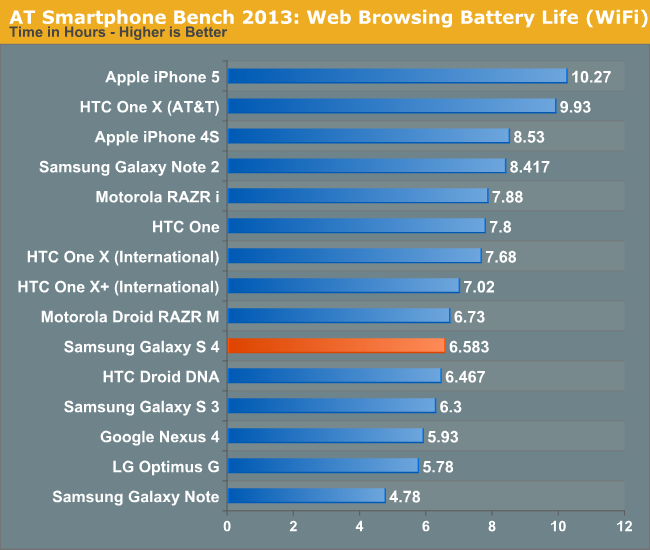
On WiFi the Galaxy S 4 falls behind the HTC One by an appreciable amount, however there's still an improvement in battery life compared to the Galaxy S 3. The Galaxy S 4's battery life isn't bad by any means, but do keep in mind that this is a large phone with a large display and a very powerful SoC. For much of the past year we've been talking about an increase in dynamic range in total platform power of high end smartphones and the Galaxy S 4 is no exception. Run it at full brightness or keep many cores running in their maximum performance states for a considerable period of time and you'll be greeted by a phone that's quickly in need of a power outlet.
As I mentioned earlier, we only have access to the Sprint version of the Galaxy S 4 at this point which unfortunately means that our 3G results aren't all that comparable to other devices here.

Even on Sprint, the Galaxy S 4 does surprisingly well.
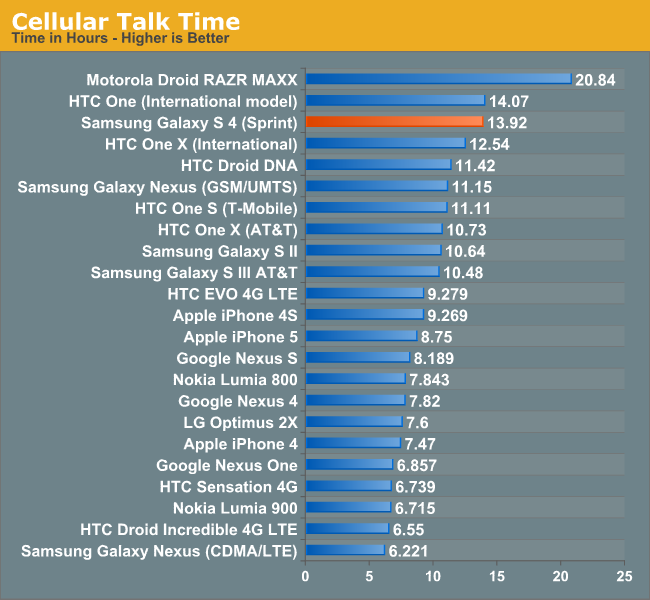
Talk time is excellent on the Galaxy S 4, with the phone delivering effectively the same battery life as the HTC One. Without having to power on that huge display, the Galaxy S 4 can last for a very long time on a single charge.
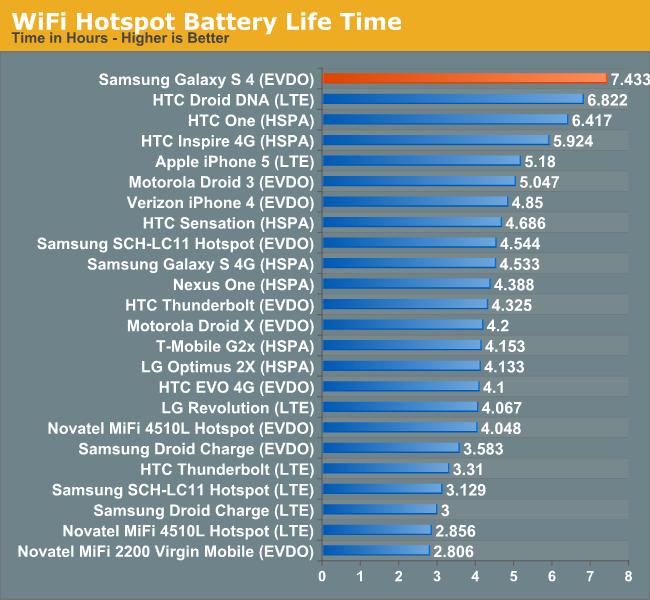
A combination of the Sprint network and the fact that the Galaxy S 4's display remains off during our hotspot test resulted in great battery life here as well. Again, this data isn't all that useful if you're not on Sprint but Samsung tells us we should be able to get our hands on an AT&T SGS4 in the not too distant future.
Charge Time
Samsung appears to implement Qualcomm's Quick Charge specification in the Galaxy S 4 and its bundled charger. I realize we haven't done a deep dive into what Quick Charge is and how it works, but I'll try to go through a quick explanation here. Most conventional chargers are linear, they take a fixed amount of input current (at 5V) and pass it along to the device being charged. The problem is that at deeply discharged states, the device's battery might be at a substantially lower voltage. A traditional linear charger won't change the current supplied based on the voltage of the battery being charged, and as a result can deliver sub-optimal charge times. When implemented, Qualcomm's Quick Charge technology can vary output current based on the voltage of the battery being charged, which results in less power being dissipated as heat and more being delivered to charging the battery itself. The table below helps illustrate the savings:
Quick Charge, at least in its currently available 1.0 specification, is still bound by the 5V limits of the USB BC 1.2 specification. The next revision of Quick Charge will enable higher voltage operation for even faster charge times.
| Qualcomm Quick Charge 1.0, Theoretical Example | ||||||
| Input Current @ Voltage | Input Power | Output Current @ Discharged Battery Voltage | Output Power | |||
| USB BC 1.2 - Linear Charger | 475mA @ 5V | 2.375W | 475mA @ 3V | 1.425W | ||
| Qualcomm Quick Charge 1.0 | 475mA @ 5V | 2.375W | 700mA @ 3V | 2.100W | ||
The non-linear nature of Quick Charge significantly shortens charge time, particularly in the very early stages of charging when the device's battery is presumably fully discharged. As the device's battery voltage increases, current delivery tapers off and the QC advantage is no longer as great as a standard USB BC 1.2 solution. The end result though is significantly improved charge times.
The graph below shows the benefits of using Samsung's own charger vs. a standard charger that implements the USB BC 1.2 specification. When used with the bundled charger, the Galaxy S 4 recharges much faster than HTC's One, despite using a larger battery. Obviously the Galaxy S 4 will charge with any USB charger, but the charge time will simply be longer. Samsung uses a voltage divider and signals the presence of their own charger by sending 1.2-1.3 V across the D+ / D- pins, this is similar to what Apple does with 2.0 or 2.8 V across the pins for various USB chargers they've shipped over the years. This signaling is essentially Samsung's proprietary tablet charging signaling which they've employed on the Galaxy Note 2 and now SGS4, in fact the two use the same exact charger, so it's worth tossing out your old ones and getting the appropriate one to take advantage of the faster charging.
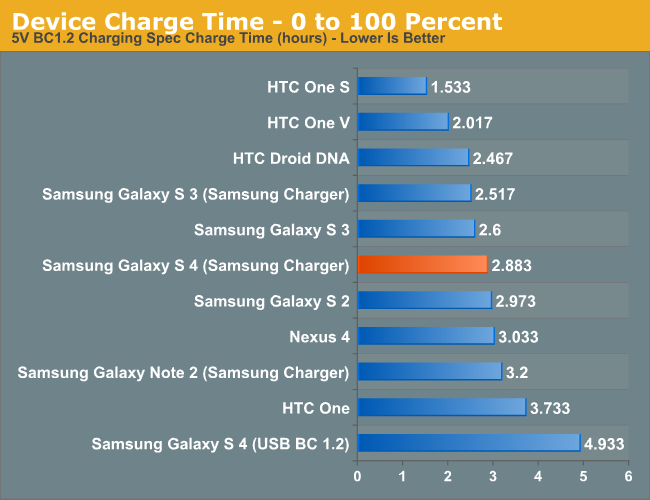


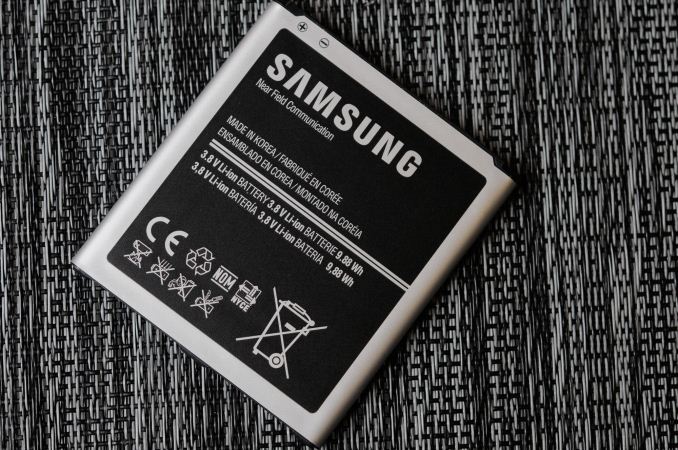








335 Comments
View All Comments
slatanek - Wednesday, April 24, 2013 - link
same goes for plastic - it can crack and scratch. and it just feels like... well plastic. Samsung phones being one of the worst when it goes to quality feel. Nokia and HTC make the best "feeling" plastic phones I reconslatanek - Wednesday, April 24, 2013 - link
oh, one more thing. materials such as aluminum, glass etc. have a premium feels to them. same for polycarbonate. the difference being how these material age. my friend has an iPhone 4S with a cracked back, but it doesn't look that bad, if anything it has a vintage look and this is how premium materials age. if you have a plastic phone thats scratched or cracked it looks pretty much like garbage. and Samsung is particulalry bad at this - making their phones plastic glossy which means it reflects light in an uneven fashion and it just looks cheap. now bare in mind we're talking about flagships, they just should feel premium. I don't mind having a plastic midrange phone but at highend I expect top notch quality not only from the internals. same applies to cars - a tuned Honda may be as fast as a Ferrari but does it mean it is equally good? I don't think so. And I don't often hear Ferrari owners complaining about leather seats "cause they scratch much more than the regular ones".superflex - Wednesday, April 24, 2013 - link
So you only cracked the back cover. How about the millions of people who dropped their plastic phone and cracked the bezel or non removable shell?Do you really think people only break the removable battery covers?
lopri - Wednesday, April 24, 2013 - link
What other Snapdragon 600 devices? (plural) It's just the S4 and the One. (OK, LG has Optimus G Pro but you didn't see the markings on the chip on it and only ran browser benches with that)Brian Klug - Wednesday, April 24, 2013 - link
I have an LG Optimus G Pro here, so that's three I guess.-Brian
CrystalBay - Wednesday, April 24, 2013 - link
Hi Brian , I would have also like to see a comparison of the external speakers quality. It seems Sammy did not learn from previous Galaxys.Roland00Address - Wednesday, April 24, 2013 - link
From WikipediaAsus Padfone Infinity, HTC One, LG Optimus G Pro, Samsung Galaxy S4 (GT-I9505), ZTE Grand Memo V9815, Xiaomi Mi-2S, Pantech Vega Iron
gnx - Wednesday, April 24, 2013 - link
The Pantech Vega Iron seemed interesting, at least in terms of casing. The soon due Lenovo K900 also is supposedly a metal-alloy, though we'll wait to see.Toss3 - Wednesday, April 24, 2013 - link
Not as thorough as the HTC One review, but the best I've read thus far. THIS is how you write an objective review. Great comparisons, and detailed information about every aspect of the device.UpSpin - Wednesday, April 24, 2013 - link
Well written review.Especially your battery run down and display analysis are one-of-a-kind. Reviews on Engadget or TheVerge test it very subjectively and dim the display to 50% software brightness (which favors OLED because at 50% the OLED display is much darker than the LCD to save power, thus SGS4 scores much longer battery life, because the test is just wrong) You set it to fixed 200nits and test it very objectively.
You also highlight issues occuring with OLED (overheating and thermal issues). Personally I think OLED is the future-proof technology (I also bought a smartphone with an OLED display), but sadly the brightness is nothing spectacular and so the color accuracy. I wouldn't buy a smartphone with OLED again, at the moment.
LCD is just better, even if black isn't true black any longer. That's a small tradeoff, therefor I get outdoor usability, color accuracy and larger sub-pixels.
In the end, one can choose between HTC One (spectacular design, great display, usable camera, usable speakers, smooth and simple software) or the SGS4 (faster SoC which sadly overheats, removable battery, expandable storage, software loaded with gimmick features which sadly slow down the whole smartphone).
Because I won't use the gimmick features, rather just even switch to Cyanogenmod, bought but almost never used the second replacement battery in my current smartphone and the whole battery life improved to at least 3-4 years (my current battery is 3 years old and runs fine), never switched my SD-Card (32GB is plenty), but want it as point-and-shoot replacement and like the look of the HTC One, it's my personal favorit.